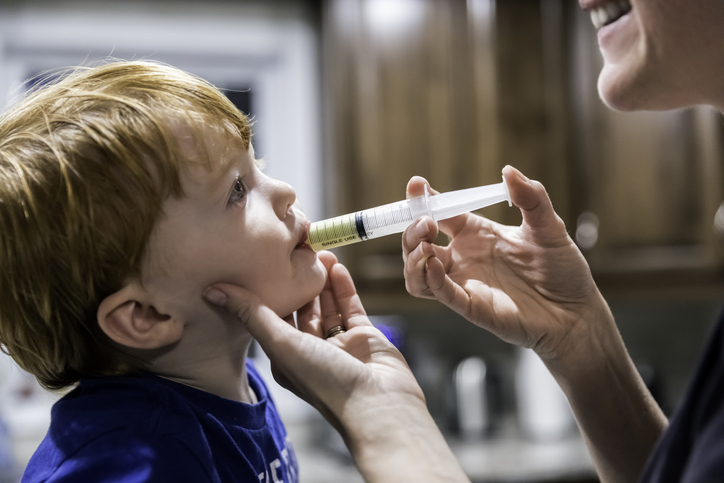The following tips will help make it easier to give your child medicine.
Tips for children 2 and younger
Stay calm. This will help your child to also stay calm and make it easier to give the medicine.
Liquid medicines are usually the best choice for giving small doses of medicines to babies and young children.
If you choose to mix the medicine with milk or formula, only use a small amount (not a full bottle) to make sure your child swallows it all and gets a full dose.
Slowly squirt or pour the medicine into your child’s mouth, towards the cheek.
Tips for children older than 2
Stay calm. This will help your child to also stay calm and make it easier to give the medicine.
Let your child feel like they have some control. Give them choices.
- For example, you can ask them if they would like to sit or stand, hold the syringe, or choose what food or drink they want to take the medicine with.
- If they are old enough, ask them what would make it easier for them to take the medicine.
Be honest and understanding.
- Let them know that you know the medicine doesn’t taste good.
- For example, you can say “I’m sorry it tastes bad”. See below for tips on how to make medicines taste better.
If your child won’t take the medicine because of the taste:
- Ask your pharmacist about other forms of medicine such as chewable tablets (pills).
- Children 5 years and older can start learning to swallow pills (tablets or capsules). To do this, try getting them to swallow small candies until they are able to swallow candies the size of their pills.
If your child won’t take their medicine, be gentle but firm and help them understand why it’s important. For example, you could say “This medicine will help you feel better.”
Let your child know that you are proud of them for taking their medicine without too much trouble. This will create a better experience and make it easier for you and your child the next time you have to give them medicine.
Liquid Medicine
Try the following when giving liquid medicine to children:
Measure small doses of medicine you give by mouth with a measuring syringe from the pharmacist. Don’t use kitchen spoons to measure. Ask your pharmacist to show you the best way to measure your child’s medicine.
If your syringes or measuring devices are broken or you can’t read the numbers on them, ask your pharmacist for a new measuring device.
Ask your pharmacist if you can mix the medicine with a small amount of juice, water, or other liquid to hide the medicine’s taste. Make sure your child drinks all the fluid to get the full dose of medicine.
If your child needs to take more than one medicine at the same time, ask the pharmacist if you can mix the medicines together.

Pills
Try the following when giving pills to children:
When your child is learning to swallow pills, it may help to put the pill on the back on the tongue and have your child take a drink right away. Some children find it helps to use a straw so they concentrate on swallowing the drink instead of the medicine.
Ask your pharmacist what to do if your child throws up the medicine less than an hour after they take it. If they throw up an hour or more after taking the medicine, you don’t have to give another dose to make up for the one they threw up.
If your child has trouble swallowing pills, ask your pharmacist if the medicine comes in a liquid form or if the pill can be crushed (tablet) or opened (capsule) and mixed with a small amount of food. Don’t crush or open pills without talking to the pharmacist first.
Tips for mixing pills with food:
- Empty out the whole pill (capsule) or crush the pills (tablets) between 2 spoons. It’s easier to crush a pill if you add a few drops of water and let it soften for a few minutes.
- Mix the crushed tablets or powder from the capsules with a small amount of food your child likes such as apple sauce, jam, chocolate spread, or pudding. Make sure your child eats all the food to get the full dose.
Helping Medicines Taste Better
If your child won’t take their medicine because they say it tastes bad, try the following:
Give your child a frozen treat before medicine to help numb the taste buds and lessen a bad taste from the medicine.
Give strong-tasting foods your child likes such as jam, syrup, chocolate, or a strong-tasting cheese (if they like it) after they take the medicine. Offering these treats may also make it easier to give your child their next dose or other medicines in the future.
Check with your pharmacist to see if you can put your child’s liquid medicine in the fridge. Liquid medicine that is cold may not taste as strong so your child may take it more easily.
Check out
Helping Medication Taste Better for more tips and information.
If you still find it hard to give your child medicines after trying these tips, talk to a member of your healthcare team, such as a doctor, nurse, or pharmacist. They can help you make a plan so your child gets the medicines they need.
